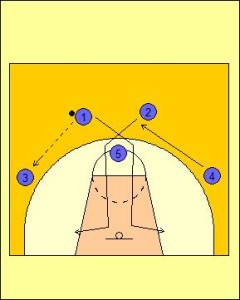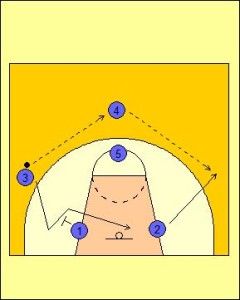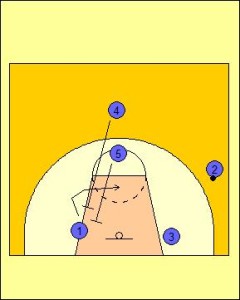High Post Offense: Cross Cut
The High Post Offense is a popular with teams who lack a strong inside presence. This can be due to an inexperienced player in this position or an undersized line-up. Either way the High Post Offense is useful at pulling the defence away from the basket and forces teams into making long close-outs which result in greater driving possibilities.
By placing the screen well above the foul line the High Post Offense Cross Cut Play increases the length of each cut to the basket initially which allows for greater speed and difficulty to guard the offensive player. As a point of note these initial cuts should be a flat out sprint and in some cases creating a lead might not be necessary if the offensive player has explosive acceleration and is able to leave their defensive match-up behind.
Another important point to realise with the High Post Offense is that the interior player if they receive a post entry pass will only have one defender between them and the basket. If a team has a gifted one on one scorer who is strong when facing up to the basket the High Post Offense might be of use in isolating this player. If the interior player is to be used in this way then the players attack on the basket will need to be swift along a linear driving lane, as the perimeter defensive players will collapse into help positions quickly to assist the isolated defender.

The High Post Offense starts in Two Three formation with the high post in between the three-point line and foul line.
One (1) makes the pass to the player in the wing position (Three). Then cuts off the screen to the weak side of the basket. One’s cut happens first so the pass is more easily made without the interior defender.
Two (2) cuts off the screen set by Five (5) to the strong side of the keyway.
Four (4) lifts to the Point Position which is now vacant.
Scoring Options:
- Five (5) on the post entry pass and isolation
- One (1) on the weak side cut to the basket
- Two (2) on the strong side cut to the basket

Three (3) reverses the ball to Four (4).
One (1) moves outside of the keyway to set a cross screen for Three (3).
As this is happening on the weak side of the floor Two (2) lifts to the vacant wing position.
Three (3) Flex Cuts over the screen set by One (1).
Depending on where the screen is set by One (1) and the vision Four (4) has, a pass might be made to Three (3). A better passing angle though will be from Two (2) into Three (3).
Scoring Options:
- Three (3) on the flex cut to the basket
- Five (5) which will lead to a High/Low situation with One (1)
- Three-point shot Four (4) and Two (2)

Three (3) continues to move through the keyway and into the short corner. This movement can be extended into a mid-range position.
Four (4) and Five (5) set a staggered screen for One (1).
Scoring Options:
- One (1) on the cut over the staggered screens
- Three (3) on pass to the strong side low post or mid-range position on the baseline
- Five (5) on a lift using Four’s (4) screen or step to the basket
The High Post Offense Cross Cut Play provides a number of different scoring options. If the time is taken to explore these and a team will become very difficult to contain and limit in offensive output.
Related articles







